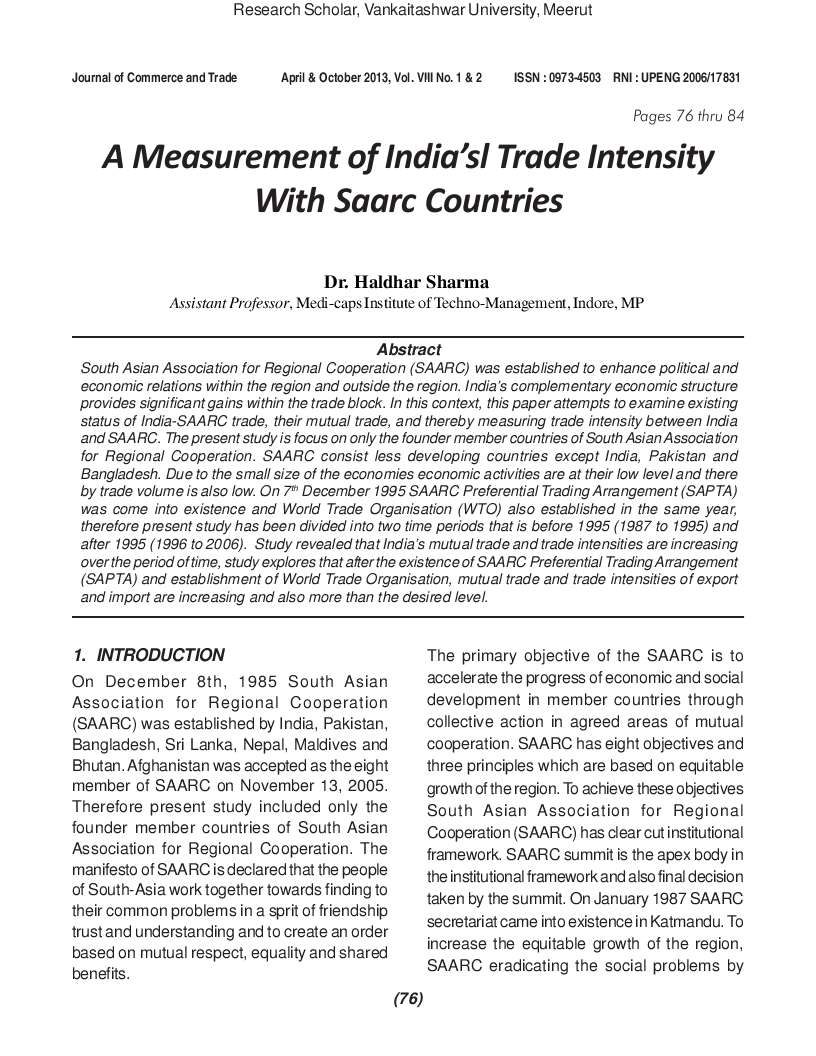A Measurement of India's Trade Intensity with SAARC Countries
DOI:
https://doi.org/10.26703/jct.v8i1-2.286Keywords:
SAARC, Trade, Foreign TradeAbstract
South Asian Association for Regional Cooperation (SAARC) was established to enhance political and economic relations within the region and outside the region. India’s complementary economic structure provides significant gains within the trade block. In this context, this paper attempts to examine existing status of India-SAARC trade, their mutual trade, and thereby measuring trade intensity between India and SAARC. The present study is focus on only the founder member countries of South Asian Association for Regional Cooperation. SAARC consist less developing countries except India, Pakistan and Bangladesh. Due to the small size of the economies economic activities are at their low level and there by trade volume is also low. On 7th December 1995 SAARC Preferential Trading Arrangement (SAPTA) was come into existence and World Trade Organisation (WTO) also established in the same year, therefore present study has been divided into two time periods that is before 1995 (1987 to 1995) and after 1995 (1996 to 2006). Study revealed that India’s mutual trade and trade intensities are increasing over the period of time, study explores that after the existence of SAARC Preferential Trading Arrangement (SAPTA) and establishment of World Trade Organisation, mutual trade and trade intensities of export and import are increasing and also more than the desired level.
Downloads
Metrics
References
Agrawal Raj, (1999), “Indian Foreign Trade”, Excel Books, New Delhi.
Agarwala Ramgopal, (2002), “Towards an Asian Economic Community: Monetary and Financial Cooperation”, RIS DP#33/2002.
Ahmad Syed Noman (2004): “Asian integration: Prospects for India’s merchandise trade”. THE INDIAN ECONOMIC JOURNAL.
Albertin Giorgia, (March 2008), “Regionalism or Multilateralism? A political Economy choice” IMF working paper March 2008.
Alatas Ali (August 2002), “International Relations in the Era of Globalization: Challenges and Opportunities for India-ASEAN Cooperation”, Fourteenth India-ASEAN Eminent Persons Lecture RIS, New Delhi August 7, 2002.
Ambatker Sanjay (Book, First Edition 2002): “India and ASEAN in the 21st Century: Economic Linkages” 8
Asher Mukul, Sen Rahul and Srivastava Sadhna (2001): “ASEAN-India: Emerging Economic Opportunity” http://www.spp.nus.edu.sg/docs/wp/wp06.pdf
Asher Mukul G.and Srivastava Sadhna (May 2003), “India and the Asian Economic Community”. RIS#DP 51/2003.
Baru Sanjay (February 2001), “India and ASEAN: The emerging Economic relationship towards a Bay of Bengal community”. ICRIER working paper No.1.
Batra Amita (December 2004), “India’s global trade potential: The growing model approach”, ICRIER working paper No. 151.
Bhattacharya, B. and M. Ariff (2000): “Study of AFTA-India Linkages for the enhancement of Trade and Investment”, a report submitted to the Government of India and the ASEAN Secretariat, May.
Gaur Seema (8th October 2003): “ASEAN-India Ties entering a new phase” http://www.iseas.edu.sg/viewpoint/sg8oct03.pdf
International Monetary Fund (IMF), 2009. International Financial Stastics Yearbook.
Joseph K. J. and Parayil Govind (April 2004): “India–ASEAN Cooperation in Information and Communication Technologies: Issues and Prospects”. RIS, New Delhi. DP # 70/2004.

Downloads
Published
How to Cite
Issue
Section
License
Copyright (c) 2013 Dr. Haldhar Sharma

This work is licensed under a Creative Commons Attribution 4.0 International License.














